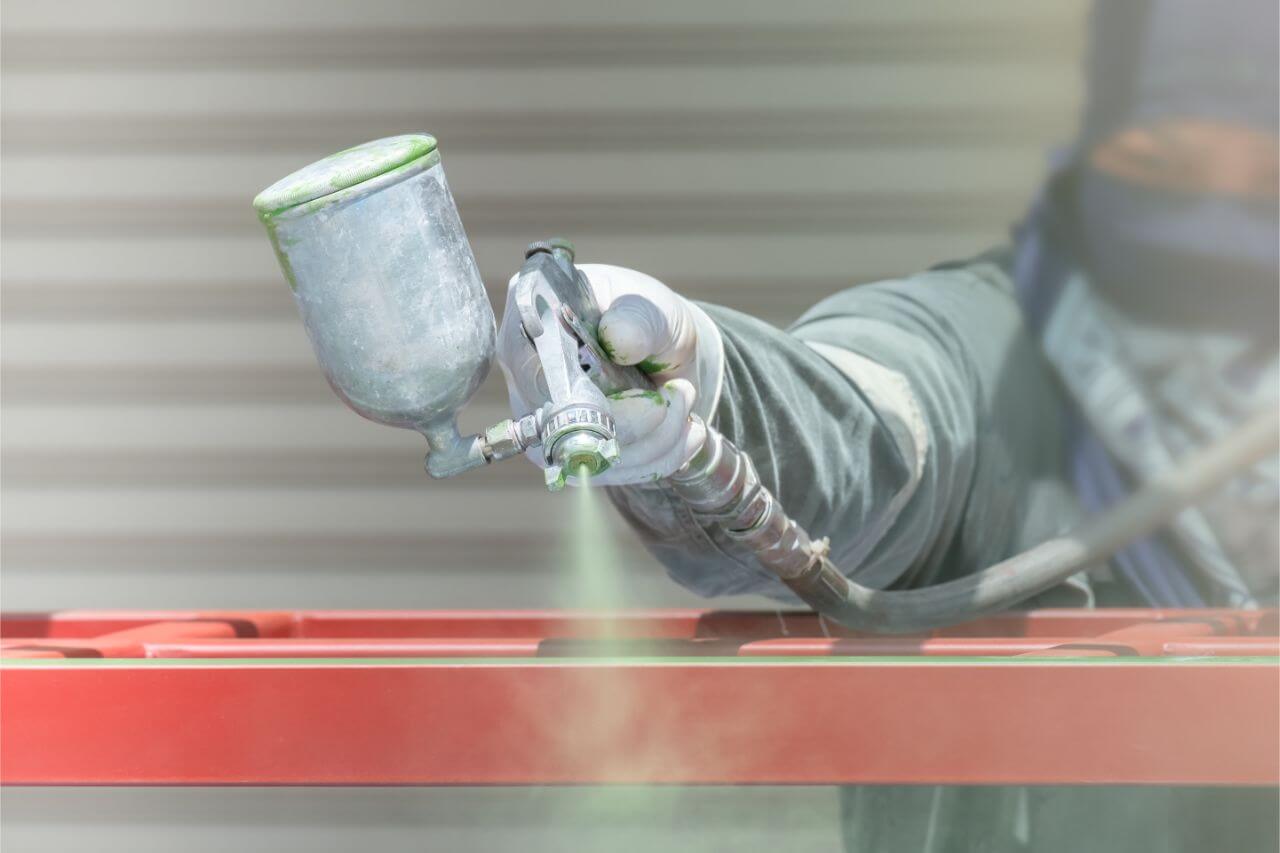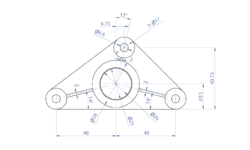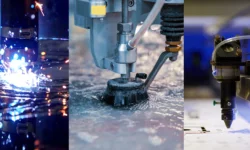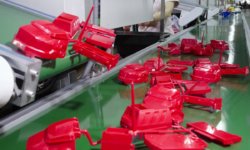Metal parts made using processes like CNC machining can be colored in different ways to meet customer specifications. For common metals like aluminum, two of the most common metal coloring techniques are powder coating and painting.
Each coloring process has its own advantages and disadvantages, though both are suitable for most metals. They are more common than other metal coloring techniques like anodization and conversion coating. This article looks at powder coating vs painting in terms of cost, durability, appearance, and thickness of the applied layer.
What is powder coating?
Powder coating is a surface finishing process for metals and other materials. It uses a dry, free-flowing powder — usually a thermoplastic or thermoset polymer — rather than liquid paint, and can be applied electrostatically to metals. Depending on the type of powder used, heat or UV light is required to cure the coating afterwards.
The powder coating process was invented in 1945 and has become a widely used process in various industries. Because it creates an exceptionally hard finish that is more durable than paint, it is used for rugged parts like bicycle frames and household appliances.
The process begins with the acquisition of the powder, which is made up of a polymer, pigments, flow modifiers, and other additives. The parts to be coated are thoroughly cleaned to remove contaminants.
Application of the powder to metal parts typically involves the uses of electrostatic spray deposition, in which an electrostatic gun or corona gun is used to give a negative charge to the powder and direct it to the (grounded) metal parts via a nozzle. The electrostatic process means the powder is attracted to the part surface, and it forms an even layer. Another powder application technique is fluidized bed application, in which the parts are pre-heated and dipped into a bed of powder.
Once the parts are coated, they must be cured, either in an oven or with UV light. Curing causes crosslinking of the powder molecules, and for most powders takes place at 200 °C or less for 10 minutes. On the other hand, UV powder coatings require less energy and cure faster.
Benefits of powder coating
Powder coating has many advantages, including excellent hardness and durability, as well as environmental benefits.
Durability
The powder coating finishing process creates a hard layer that is highly resistant to chips, scratches, peeling, and chemicals. It can also achieve consistent, high-quality thick coatings that do not run or sag. In general, powder coatings can last up to 20 years before beginning to degrade. Degradation can be accelerated by exposure to UV, heat, moisture, etc. However, powder coating does not rust.
Environment
Powder coatings release negligible amounts of volatile organic compounds (VOCs) and contain no solvents, benefitting both the environment and worker health. Specialist equipment is therefore not required to capture excess powder, which makes compliance with environmental regulations more easily achievable. Furthermore, excess powder (overspray) can be stored and reused on another cycle, reducing waste.
Appearance and special effects
Unlike other color finishing techniques, powder coating produces minimal differences in appearance between surfaces coated horizontally and those coated vertically. Color vibrance lasts a long time, and special effects can be achieved such as wrinkles and river veins. Such effects may be desirable in the luxury automotive industry, for example.
Curing time
Curing rarely takes more than 10 minutes, and can be significantly faster when using a UV-curable coating, making the process faster than some other finishing techniques. Additionally, powder coating typically only requires a single layer, whereas painting can require multiple coats.
Limitations of powder coating
Powder coating is not suitable for all metal parts, despite its important advantages. Its limitations include its cost and potential tolerance issues.
Cost
Powder coating is more expensive than spray painting — moderately so at a large industrial scale and significantly so at a small/DIY scale, as expensive equipment is required. This may or may not be offset by certain cost savings such as overspray recycling.
Coat thickness
While the thickness of the powder coating can have advantages in terms of durability, it can be an issue if parts have critical tight tolerances, as it is difficult to achieve a very fine coating.
What is painting?
Spray painting is a widely used finishing technique for metal parts, used to add color and texture and to provide a protective finish. Unlike powder coating, painting involves the use of a liquid (oil or water-based) solvent containing pigment and various additives. A pneumatic spray gun is used to spray the paint onto the surface of metal parts.
The use of spray painting with compressed air began in the 1880s in Chicago, and the technique became widespread due to its significant speed improvements over manual brush painting. Today, spray painting can be automated on production lines for maximum efficiency.
The simplest form of spray painting is air gun spraying. During this spray painting process, an air-pressurized spray gun — either held by an operator or mounted — ejects the liquid paint as a fine spray from a nozzle, usually at a distance of around 15–25 centimeters from the metal part. The paint becomes hard on the surface of the part as the solvent evaporates. With this process, the consistency of the paint can be varied using different nozzles.
Other spray painting methods include electrostatic spray painting, airless spray guns with high-pressure pumps, and spray booths.
Benefits of painting
When it comes to finishing aluminum and other metal parts, spray painting has numerous benefits, such a broad range of colors, thin layers, and low setup costs.
Color options
In terms of both readily available colors and custom mixing, spray painting offers a very broad range of color and texture options — broader than powder coating and alternative coloring techniques.
Coat thickness
Painting may be preferable for maintaining tight tolerances, as the thickness of the coating is much finer than powder coating, so rarely affects the fit and form of components in an assembly. Spray painting can have a finish thickness as low as 1 mil (0.025 mm), whereas powder coating can only go as low as about 2.5 mils (0.0625 mm). On the other hand, the thicker layers created by powder coating add to their durability.
Cost
Spray painting costs less than powder coating, both in terms of setup/equipment and production of each unit.
Limitations of painting
Spray painting has certain limitations, including limited durability, inconsistent application, and environmental concerns.
Durability
Paint is less resistant to chipping, scratching, and peeling than powder coating and does not last as long. However, it is relatively easy to apply fresh coats of paint to worn-out parts.
Application
Spray painting offers some challenges in terms of successful application and coverage. For one, it is more difficult to achieve consistent coverage and thickness across a part, especially when applying the paint using a handheld gun. Additionally, spray painting typically requires several coatings and drying time in between each application.
Environment and safety
Because paints contain solvents, they are worse for the environment and must be disposed of carefully. Furthermore, spray painting can be hazardous for workers, posing a risk to the respiratory, nervous, and circulatory systems. Use of PPE is required, and paints must be stored carefully to minimize risk of fire.
Comparison of powder coating and painting
As a general rule, powder coating is a better option than painting if the manufacturer needs to prioritize durability and appearance of their metal parts while minimizing environmental hazards. However, it typically costs more than painting. Spray painting is a better option when a very thin finish is required to meet tight tolerances, when the part contains plastic components that would melt during oven curing, or when the manufacturer requires a specific color that is not available in powder form.
Metal finishing with 3ERP
3ERP offers a range of finishing options for metal parts, including powder coating and spray painting. If unsure about which finishing option will work best for your parts, speak to our team or make a note when you request a quote.








